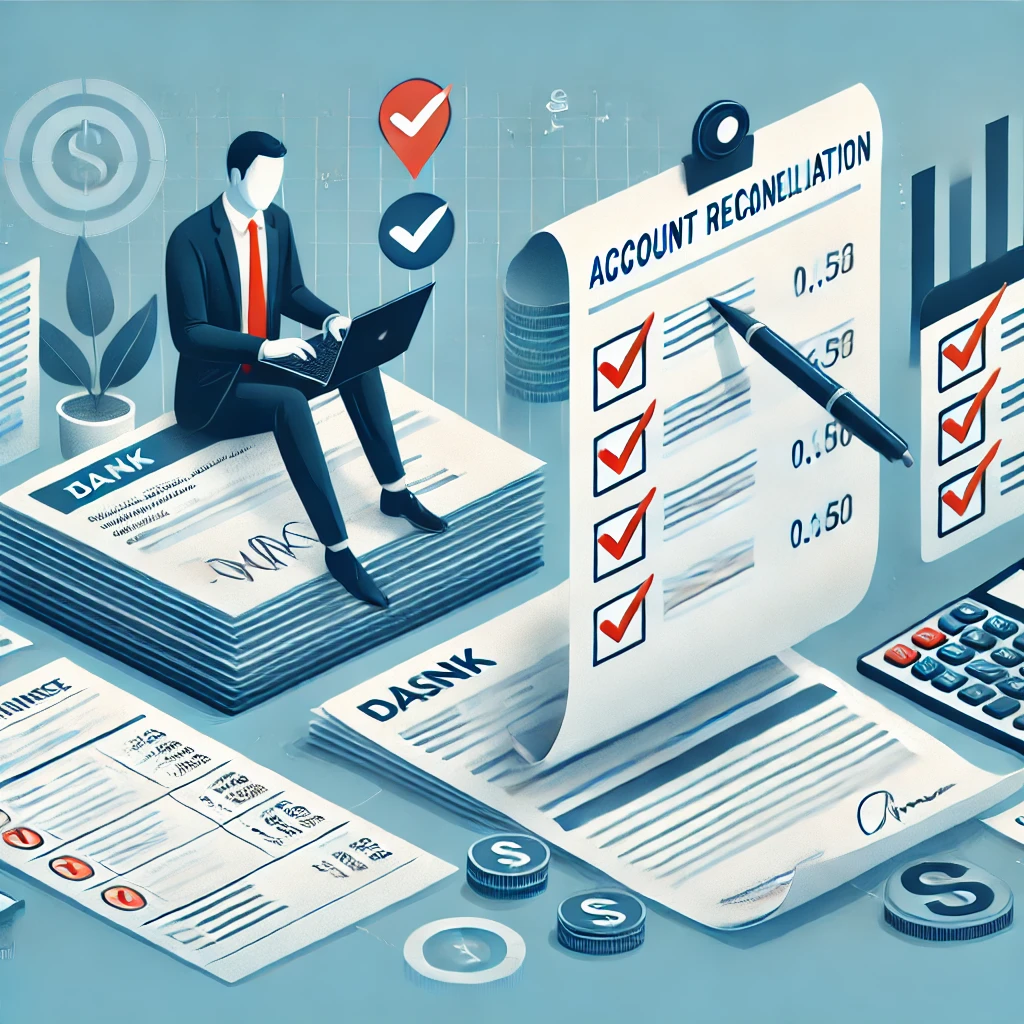How to perform account reconciliation to improve your business finances
Struggling with mismatched financial records, missing transactions, and the stress it brings? Account reconciliation can feel overwhelming, but it’s essential for catching errors, preventing fraud, and ensuring compliance. For businesses, accurate records are crucial for informed decision-making and financial health. So, if you’re looking for information on account reconciliation and how to perform it, here is everything you need to know!

What is account reconciliation?
Account reconciliation is the process of comparing two sets of financial records to make sure they match. The main goal is to identify and fix any discrepancies to ensure accurate financial statements. This is important for both businesses and individuals to catch errors, prevent fraud, and maintain accurate financial statements. Whether it’s balancing a personal checkbook or verifying business transactions, reconciliation helps manage finances effectively.
History and evolution of account reconciliation
Reconciliation has been a key part of accounting for centuries. It all started with the development of double-entry bookkeeping in the 15th century. This system, introduced by Luca Pacioli, was groundbreaking because it made sure every financial transaction was recorded in two places, which helped reduce errors.

Advancements over time
Over the years, the reconciliation process has become more streamlined and efficient. Technological advancements have played a big role in this. Today, we have software tools and automated systems that help accountants perform reconciliations more quickly and accurately than ever before.
Importance of account reconciliation in modern accounting
Ensuring accurate financial records
Account reconciliation helps maintain accurate financial records. By comparing financial statements with actual transactions, you can spot and correct any discrepancies, ensuring your records are up-to-date and precise.
Detecting errors and fraud
Reconciliation is key to detecting errors and fraud. By regularly reviewing financial records, you can quickly identify unusual transactions or mistakes, helping to prevent and address potential issues before they escalate.
Facilitating financial decision-making
Accurate records are essential for good financial decision-making. When your accounts are reconciled, you have reliable data on which to base your budgeting, forecasting, and strategic planning, leading to better financial outcomes.
Compliance with legal and regulatory requirements
Regular reconciliation helps ensure compliance with legal and regulatory requirements. Accurate financial records are often required by law, and reconciliation ensures you meet these standards, avoiding potential fines or legal issues.

Types of account reconciliations
Bank reconciliation
Bank reconciliation involves comparing your company’s financial records to the bank statements to ensure they match. This process helps identify any discrepancies and ensures your financial records are accurate.
Step-by-step process for bank reconciliation:
Step 1: Gather statements
Collect your bank statements and financial records. Ensure you have all necessary documents, including transaction receipts and bank statements.
Step 2: Compare records
Match each transaction in your records to the bank statement. Check off each transaction to ensure both sets of records align.
Step 3: Identify discrepancies
Note any differences, such as missing transactions or errors in amounts, and investigate them to understand the cause.
Step 4: Adjust entries
Make necessary corrections to your financial records to fix any discrepancies found. This might include adding missing transactions or correcting amounts.
Credit card reconciliation
Credit card reconciliation is crucial for tracking expenses and preventing fraud. It involves comparing credit card statements to your financial records.
Steps for credit card reconciliation
Step 1: Collect statements
Gather your credit card statements and internal financial records.
Step 2: Match transactions
Compare each transaction in your records with the credit card statement, verifying dates and amounts.
Step 3: Resolve discrepancies
Identify and address any differences. This might include disputing fraudulent charges or correcting entry errors.
Vendor reconciliation
Vendor reconciliation ensures that your records of payments to suppliers match the vendor’s records. This helps maintain good relationships and prevents disputes.
Steps for vendor reconciliation
Step 1: Collect statements
Obtain statements from your vendors, including all invoices and payment records.
Step 2: Match invoices
Compare each invoice with your records, verifying that amounts, dates, and items match.
Step 3: Resolve discrepancies
Communicating with the vendor to address any differences might involve providing proof of payment or requesting a corrected invoice.
Customer reconciliation
Customer reconciliation ensures your records of sales and payments received match the customer’s records. This is essential for maintaining accurate accounts receivable.
Steps for performing customer reconciliation
Step 1: Gather customer statements
Obtain the customer’s account statements, including all invoices and payment records.
Step 2: Match transactions
Compare each transaction with your records, verifying that amounts, dates, and items match. Check off each matched transaction to ensure completeness.
Step 3: Identify discrepancies
Note any differences and investigate them. This might involve verifying if payments were received or if invoices were issued correctly.
Step 4: Communicate
Resolve any issues with the customer to ensure both records are aligned. This might include providing proof of payment or issuing corrected invoices.

Detailed step-by-step guide steps to perform account reconciliation
Step 1: Gathering necessary documents
Start by collecting all the documents you need, such as bank statements, credit card statements, vendor invoices, customer statements, and your internal financial records. Make sure you have everything for the period you’re working on. Keeping organized files and ensuring all documents are up-to-date can make this step smoother.
Step 2: Comparing records
Next, go through your financial records and match each transaction with the ones in your statements. Check off each transaction to ensure they align perfectly. This helps to ensure all transactions are accurately recorded. Pay special attention to dates and amounts to catch any discrepancies quickly.
Step 3: Investigating discrepancies
If you find any mismatches, take time to investigate them. Look for missing transactions, errors in amounts, or duplicates. Understanding why discrepancies exist is key to resolving them. Sometimes it might be a simple clerical error, while other times it could be an unrecorded transaction that needs to be added.
Step 4: Adjusting entries and updating records
After identifying discrepancies, correct them in your records. Update your financial documents to reflect these changes. This step ensures that your records are accurate and complete. Make a note of all adjustments made for future reference and to maintain transparency.
Why accounting reconciliation matters for businesses?
Accounting reconciliation is a fundamental process for businesses, crucial in maintaining financial accuracy, detecting errors, and fostering trust among stakeholders. Here’s how reconciliation supports various aspects of business operations:
Accurate financial records
Reconciliation ensures financial records are both accurate and reliable by cross-verifying different sets of data. When businesses process transactions, discrepancies or errors can arise. Reconciliation helps identify and correct these issues, ensuring that financial statements reflect a true and fair view of the business’s financial position.
Fraud detection
As a vital internal control mechanism, reconciliation helps detect fraudulent activities. By comparing records like bank statements, invoices, and payment receipts, businesses can spot discrepancies that might indicate fraud, protecting their assets and financial integrity.
Informed decision-making
Reliable data is essential for sound decision-making. Reconciliation confirms that financial information is complete and precise, giving businesses the confidence to make strategic decisions based on trustworthy data.
Compliance with regulatory standards
Reconciliation plays a crucial role in meeting regulatory and compliance obligations. For example, accurate bank reconciliation ensures alignment with auditing standards and regulatory guidelines, helping businesses avoid noncompliance, penalties, or legal issues.
Risk management
By identifying errors or irregularities early, reconciliation supports effective risk management. This process enables businesses to spot potential risks like cash flow inconsistencies, inventory discrepancies, or tax miscalculations, allowing them to take proactive steps to maintain financial stability.
Building stakeholder trust
With thorough reconciliation practices, businesses demonstrate transparency and integrity in their financial statements. This builds trust and credibility among stakeholders, including investors, lenders, and shareholders, and strengthens the company’s reputation, ultimately reinforcing confidence in its financial health.
Reconciliation best practices
Regular and consistent reconciliation schedules
Set a regular schedule for reconciliation, like monthly or quarterly. This helps catch mistakes early and keeps your records accurate. Consistency helps prevent small errors from becoming larger issues over time.
Using software and tools for efficiency
Use accounting software to make the process easier. These tools can automatically match transactions, highlight discrepancies, and generate reports, making reconciliation faster and more accurate. They can also provide useful features like reminders and automated alerts for any irregularities.
Training and involving staff in the process
Train your staff on how to perform reconciliations and explain why it’s important. Involving them ensures everyone understands the process and helps maintain accurate records. Regular training sessions can also help staff stay updated on best practices and new tools that can aid in the reconciliation process.
Common reconciliation challenges and solutions
Timing differences
A frequent challenge in reconciliation is timing differences, where transactions appear in one set of records but not the other. For example, a bank deposit might not appear in the bank statement immediately. Address this by regularly updating and reviewing records to account for these delays.
Data entry errors
Another common issue is data entry errors, such as typos or incorrect amounts. These can occur when manually entering data into financial records. Conducting periodic audits can help spot and correct these mistakes early. Using accounting software can also reduce the risk of human error.
Unrecorded transactions
Sometimes, transactions are simply not recorded in the financial records. This could be due to oversight or delays in documentation. Regularly cross-checking bank statements and internal records helps ensure all transactions are accounted for.
Duplicate entries
Duplicate entries can inflate financial figures and cause discrepancies. Regularly reviewing transactions and using software with duplicate detection features can help prevent this issue.
Addressing discrepancies
When discrepancies are found, it’s important to investigate them thoroughly. This may involve tracing the transaction history, contacting banks or vendors, and making the necessary corrections to the records.
Key takeaways
- Account reconciliation ensures accurate financial records.
- It helps detect errors and fraud.
- Facilitates informed financial decision-making.
- Ensures compliance with legal and regulatory requirements.
- Types include bank, credit card, vendor, and customer reconciliations.
- The process involves gathering documents, comparing records, investigating discrepancies, and adjusting entries.
- Best practices include regular schedules, using software, and training staff.
- Common challenges are timing differences and data entry errors.
- Preventative measures include regular updates, software use, and staff training.
FAQs
What is the purpose of reconciliation?
The purpose of reconciliation is to ensure that financial records are accurate and match external documents like bank statements. This helps catch errors, prevent fraud, and provide a clear financial picture.
How often should reconciliation be done?
Reconciliation should be done regularly, typically monthly, to ensure records are accurate and up-to-date. More frequent reconciliation may be necessary for businesses with high transaction volumes.
What documents are needed for reconciliation?
You’ll need bank statements, credit card statements, vendor invoices, customer statements, and internal financial records. Having these documents helps verify transactions and identify discrepancies.
Can software help with reconciliation?
Yes, accounting software can streamline the reconciliation process by automatically matching transactions, highlighting discrepancies, and generating reports. This reduces manual work and errors.
What happens if discrepancies are found during reconciliation?
If discrepancies are found, they need to be investigated and resolved. This could involve correcting data entry errors, updating records, or contacting banks or vendors for clarification.


